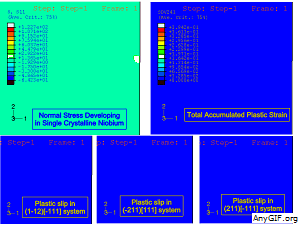Metal/Ceramic Interface Fracture
Metal/ceramic interface fracture of niobium/alumina bicrystal interface had been studied at Max-Planck Institute for metal research, Stuttgart, Germany since last three decades. It was found that fracture energy of the system changes in some case by 20 times for different orientations of the bicrystal specimen. In this work a length scale bridging procedure was proposed to simulate the interface fracture of niobium/alumina bicrystal specimens. An automatic identification procedure has been proposed to identify crystal plasticity parameters involved in the material constitutive equations. Using this procedure, a large number of parameters can be identified in few minutes that used to take weeks if done manually. Effect of crystal orientation on the crack initiation energies was studied. It was found that by changing the orientation of the single crystalline material does influence the fracture energies of the bicrystal interface. The trends of these fracture energies were found to be the same as were found in the experiments. The physical phenomena involved in the variation of fracture energies for different orientations of the interface were explained quantitatively using the analyses results. A correlation was derived among macroscopic parameter (fracture energy), and micro- and nano-scale parameters, such as cohesive strength, work of adhesion and yield stress.
Related Animations:
– Crystal Orientation: Nb(100)[001]|Sp(11-20)[0001]– Crystal Orientation: Nb(110)[001]|Sp(11-20)[0001]

Selected Publications
A. Siddiq, S. Schmauder, Simulation of hardening in high purity niobium single crystals during deformation. Steel Grips, Journal of Steel and Related Materials , Vol. 3 (4), pp. 281-286, 2005. PDFA. Siddiq, S. Schmauder, Crystal plasticity parameter Identification procedure for single crystalline material during deformation. Journal of Computational and Applied Mechanics , 7 (1), pp. 1-15, 2006. PDFA. Siddiq, S. Schmauder, Modelling of Crystal Plasticity Effects on the Crack Initiation Energies of a Bi-Crystal Interface (Nb/Al2O3). Computer Assisted Mechanics in Engineering Sciences , 14 (1), 67-78, 2007. PDFA. Siddiq, S. Schmauder, Y. Huang, Fracture of bicrystal metal/ceramic interfaces: A study via the mechanism-based strain gradient crystal plasticity theory. International Journal of Plasticity , 23 (4), 665-689, 2007. PDFA. Siddiq, S. Schmauder, Interface fracture analyses of a bicrystal specimen using cohesive modelling approach. Modelling and Simulation in Material Science and Engineering , 14 (6), 1015-1030, 2006. PDFA. Siddiq, S. Schmauder, M. Ruhle, Niobium/alumina bicrystal interface fracture: A theoretical interlink between local adhesion capacity and macroscopic fracture energies, Engineering Fracture Mechanics 75, 2320-2332, 2008. PDFI. H. You, W. Lutz, H. Gerger, A. Siddiq, A. Brendel, S. Schmauder, Dynamic Fiber Push-out Study of a Copper Matrix Composite: Experiment and Simulation based on Cohesive Finite Elements, International Journal of Solids and Structures, 46, 4277-4286, 2009.
